
The Chinese mantis is a species of mantis native to Asia and the nearby islands. In 1896, this species was accidentally introduced by a nursery tender at Mt. Airy near Philadelphia, United States. Tenodera sinensis often is erroneously referred to as Tenodera aridifolia sinensis because it was at first described as a subspecies of Tenodera aridifolia, but Tenodera sinensis is now established as a full species.

Iris oratoria, known by the common name Mediterranean mantis, due to humans first studying it in lands around the Mediterranean Sea, is a species of praying mantis. Its range is expanding in the Middle East, Western Asia and the United States.
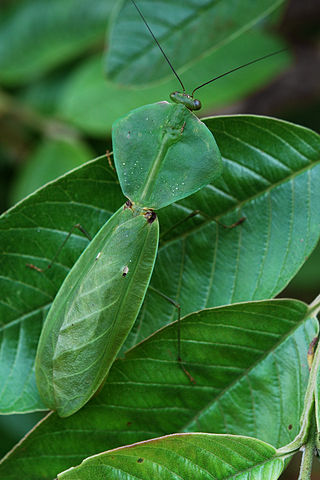
Choeradodis is a genus of praying mantises with common names such as shield mantis, hood mantis, and leaf mantis because of their extended, leaf-like thoraces. The distinguishing characteristic of Choreododis from which it takes its common names is a laterally expanded thorax. This adaptation for the purpose of camouflage, as well as a rounded wing case and a habit of staying relatively flattened, aid its leaf mimicry. Tiny liverworts, lichens and fungi have been found growing on the pronotum and wing case of many Choeradodis mantids; these appear to be opportunistic growths rather than an example of coevolution with the mantids to afford extra camouflage.

Tenodera angustipennis is a species of mantis native to Asia and nearby areas of Oceania. The species was introduced and became established in the eastern United States. Tenodera angustipennis was noticed as early as 1921 in Aberdeen, Maryland, but that occurrence was not noted in a published record until 1933.
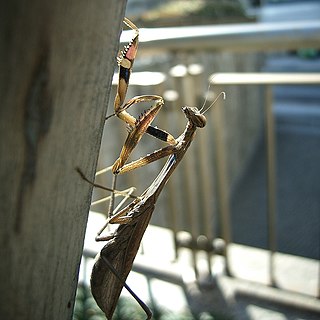
Statilia maculata, common name Asian jumping mantis or "小蟷螂", ko-kamakiri or "좀사마귀", joem-sa-ma-gui, is a species of mantis native to Asia that can be found in Romania, China and Japan and Korea, Jamaica and Sri Lanka.

Ameles spallanzania, common name European dwarf mantis, is a species of praying mantis.
Paratoxodera cornicollis, common name giant Malaysian stick mantis, is a species of praying mantis found in Indonesia (Java).
Paratoxodera borneana, common name Borneo stick mantis, is a species of praying mantis found in Brunei that was originally identified as a subspecies of P. cornicollis. In 2009 when the tribe Toxoderini was revised, borneana was classified as a morph due to the lack of major characteristics that distinguish it from cornicollis besides for the absence of a second lobe of the pronotum.
Paratoxodera meggitti is a species of praying mantis found in southern China, Myanmar, West Malaysia, and Borneo.

African mantis and African praying mantis are common names for many species of praying mantis native to Africa.

Sphodromantis gastrica, with the common names African mantis or common green mantis, is a species of praying mantis from Africa.

Choeradodis stalii is a species of praying mantis with common names that include tropical shield mantis, hooded mantis, and leaf mantis. It is found in Brazil, Ecuador, French Guiana, Panama, and Peru.

Zoolea is a South American genus of praying mantises.

Paralygdamia madagascariensis is a species of praying mantis native to Madagascar.

Bolbe pygmaea is a species of praying mantis in the family Nanomantidae. It is endemic to Australia.
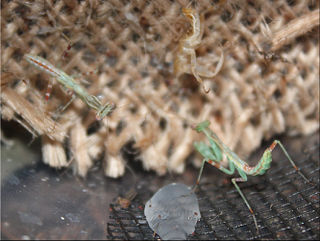
Miomantis binotata, the African pinstripe mantis, is a small species of praying mantis found in Africa that are bred in captivity in the pet trade.

Mantises are an order (Mantodea) of insects that contains over 2,400 species in about 460 genera in 33 families. The largest family is the Mantidae ("mantids"). Mantises are distributed worldwide in temperate and tropical habitats. They have triangular heads with bulging eyes supported on flexible necks. Their elongated bodies may or may not have wings, but all Mantodea have forelegs that are greatly enlarged and adapted for catching and gripping prey; their upright posture, while remaining stationary with forearms folded, has led to the common name praying mantis.
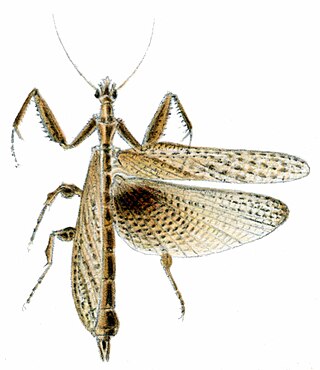
Stenophylla is a genus of praying mantis in the subfamily Stenophyllinae, which is now placed in the family Acanthopidae. It the sole genus of the tribe Stenophyllini.
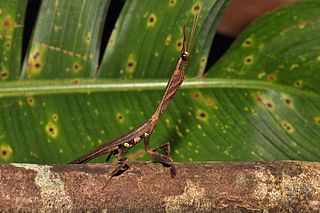
Ceratocrania macra is a mantis species in the family Hymenopodidae. The English common name is bark horned mantis. No subspecies are listed. It is found in Java, Borneo, and Sumatra.

Coptopterygidae is a family of mantises in the order Mantodea. There are at least 2 genera and more than 20 described species in Coptopterygidae.
















